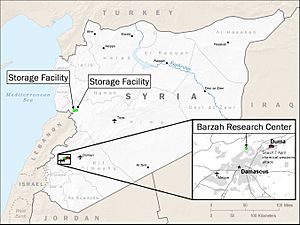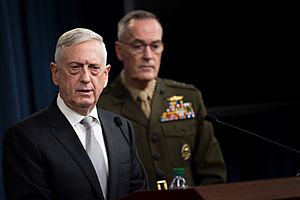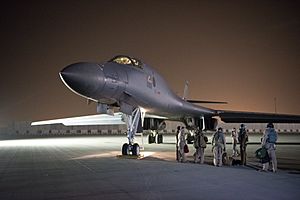April 2018 missile strikes against Syria facts for kids
Quick facts for kids 2018 missile strikes against Syria |
|
|---|---|
| Part of US attacks against Syria, the American-led intervention in the Syrian Civil War and the foreign involvement in the Syrian Civil War | |

A map of the attack sites, according to the US Department of Defense
|
|
| Location | |
| Planned by | |
| Commanded by | |
| Objective | Degrade Syria's facilities for production of chemical weapons and deter their use |
| Date | 14 April 2018 |
| Executed by | |
| Outcome | All targets either destroyed or severely damaged (US claim) Minimal damage (Syrian claim) |
| Casualties | 6 soldiers and 3 civilians injured (Syrian government claim) |
On April 14, 2018, the United States, France, and the United Kingdom launched military strikes in Syria. They used aircraft and missiles fired from ships. These attacks targeted several government sites during the Syrian Civil War.
The strikes were a response to a suspected Douma chemical attack on civilians. This attack happened on April 7, and many believed the Syrian government was responsible. The Syrian government, however, said the airstrikes broke international law.
Contents
Why Did the Strikes Happen?
The Douma Chemical Attack
In early 2018, the Syrian government was trying to take back areas held by rebels. One of these areas was Douma. On April 7, 2018, there was a suspected chemical attack in Douma. Reports said at least 70 people died. Many more suffered from the effects.
Groups like the White Helmets said that Syrian Air Force helicopters dropped bombs. These bombs were filled with chlorine gas and possibly sarin, which are dangerous chemicals. The World Health Organization (WHO) also reported that many people showed signs of being exposed to toxic chemicals.
Later, the Organisation for the Prohibition of Chemical Weapons (OPCW) found traces of chlorine at the attack sites.
Who Was Blamed for the Attack?
France, the United Kingdom, and the United States blamed the Syrian government for using chemical weapons. They said they had proof from samples collected.
However, Russia and Iran, who are allies of Syria, said no chemical weapons were used. They claimed the attack was a "false flag" operation. This means they believed someone else staged the attack to make it look like the Syrian government was responsible. Russia even said videos of the attack were fake.
International Response and Warnings
After the suspected chemical attack, Western countries started thinking about military action. They wanted a strong response. On April 10, the United Nations Security Council held an emergency meeting. Different ideas were discussed, but Russia used its veto power. This meant no plan for military action could be approved by the Security Council.
The Syrian government invited the OPCW to investigate the sites. They said they wanted to cooperate to find the truth. Meanwhile, the UK moved its Royal Navy submarines closer to Syria. They were ready to fire cruise missiles if needed.
How the Military Action Unfolded
What International Law Says
Normally, countries need permission from the United Nations Security Council to use force against another country. This is to keep international peace. However, some argue that force can be used without permission in certain cases. These include self-defense or protecting people from terrible harm by their own government.
The strikes happened just hours before OPCW inspectors were supposed to arrive in Syria. The United Kingdom said its limited strikes were justified to help people. They also wanted to make sure chemical weapons are not used again.
Which Forces Were Involved?

The United States, United Kingdom, and France carried out the strikes. They used cruise missiles launched from ships, submarines, and aircraft.
- United Kingdom: Four Royal Air Force Tornado GR4 jets fired eight Storm Shadow missiles.
- France: The French Navy sent several ships, and one frigate fired three MdCN missiles. The French Air Force used five Rafale B jets, each carrying two SCALP EG missiles.
- United States: Two US Air Force B-1B Lancer bombers fired 19 JASSM missiles. Several US Navy ships, including the USS John Warner, USS Laboon, USS Monterey, and USS Higgins, fired a total of 70 Tomahawk cruise missiles.
Where Were the Strikes Aimed?
The US military said three main sites were targeted:
- A scientific research center in Damascus.
- A chemical weapons storage facility west of Homs.
- An equipment storage facility and command post, also near Homs.
The UK Ministry of Defence confirmed its aircraft hit the Him Shanshar chemical weapons storage site. Witnesses reported loud explosions in Damascus. The scientific research center in Barzeh was destroyed. US officials said this center was used for chemical and biological weapons research.
Syria used its air defense systems to try and stop the missiles. Syrian state media claimed they intercepted most of the missiles. Russia also said that Syria's air defenses shot down 71 out of 103 cruise missiles. However, the US and France said their missiles hit their targets without being stopped.
What Happened After the Strikes?
Workers at the destroyed laboratory in Syria said they never made any chemical weapons.
Russia asked for an emergency meeting of the United Nations Security Council. They wanted the Council to condemn the attacks, but their resolution failed. The US ambassador to the UN, Nikki Haley, warned that the US was "locked and loaded" if Syria used chemical weapons again.
Some analysts said the strikes did not have a huge impact. In Syria, some saw the limited strikes as a victory for President Bashar al-Assad. They thought it meant Western countries were not serious about challenging his rule.
After the attack, there was a big increase in online activity from groups that spread false information. The US and UK warned about a Russian global hacking campaign.
Later, there were conflicting reports about how many missiles were actually intercepted. Russia claimed they had recovered some unexploded missiles. They said they would study them to improve their own weapons. The US called these claims "absurd."
The OPCW Fact-Finding Mission visited Douma to collect samples and interview people. They are still analyzing the samples to find out more about the chemical attack.
What Did Countries Say?
Syria's Reaction
Syrian state media called the attack a "clear violation of international law." Crowds gathered in Damascus to celebrate what they saw as the success of the Syrian Army in defending against the strikes.
Reactions from Allied Nations
- France: President Emmanuel Macron said France's "red line" had been crossed. This meant that the use of chemical weapons was something France would not tolerate.
- United Kingdom: Prime Minister Theresa May said there was "no practical alternative" to using force. She believed it was necessary to stop Syria from using chemical weapons. Some politicians in the UK disagreed with her decision to act without getting approval from Parliament first.
- United States: President Donald Trump announced the strikes on TV. He said they were to stop Assad from using chemical weapons. He also said the US was ready to continue this response if needed. Some US lawmakers supported the strikes but criticized Trump for not getting approval from Congress.
US military officials later confirmed that Russian air defenses were active during the strikes but did not fire any missiles.
Reactions from Syria's Allies
- Iran: The Iran Foreign Ministry condemned the strikes. They said there was "no proof" Syria was responsible for the chemical attack. Iran's Supreme Leader, Ali Khamenei, called Trump, May, and Macron "criminals."
- Russia: President Vladimir Putin called the strikes an "act of aggression." Russia also asked for an emergency meeting of the UN Security Council. A Russian general said Russia might send advanced missile systems to Syria.
Other Countries and Groups
Many other countries, including Germany, Canada, and Spain, supported the decision to attack.
The Secretary-General of the United Nations, António Guterres, asked all countries to show restraint. The European Union and NATO supported the strikes. However, the Collective Security Treaty Organization said the strikes broke international law.
Some rebel groups in Syria criticized the strikes for not going far enough. They felt the attacks punished the "instrument of the crime" but left the "criminal" (Assad) in power.
Religious leaders in Syria also condemned the strikes. They said the bombings violated international laws and encouraged terrorist groups.
Public Opposition in the West
There were protests against the strikes in the United Kingdom. Groups like the Stop the War Coalition said the strikes risked causing a "catastrophic war with Russia." They also criticized the Prime Minister for acting without Parliament's approval.
Images for kids
See also
 In Spanish: Bombardeos de Damasco y Homs para niños
In Spanish: Bombardeos de Damasco y Homs para niños
- 2017 Shayrat missile strike
- September 2016 Deir ez-Zor air raid
- International reactions to the 2013 Ghouta chemical attack § Military options
- Operation Odyssey Dawn
- List of United States attacks on Syria during the Syrian civil war



